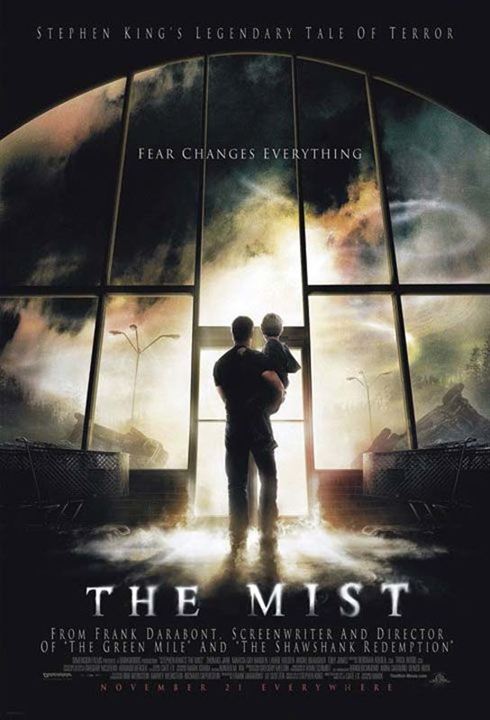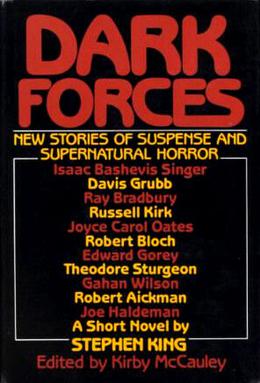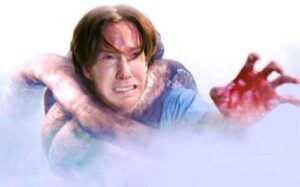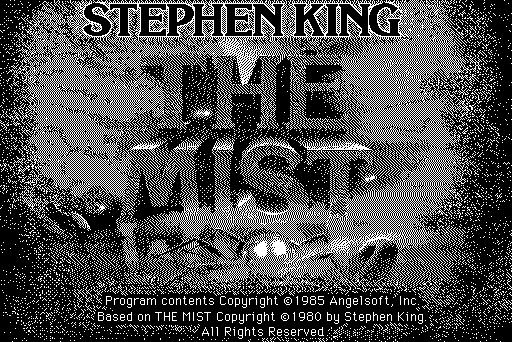Frank Darabont’s THE MIST was the most widely debated horror movie of 2007. A Stephen King adaptation with a difference (it’s actually good), this monster-packed scare fest inspired an astonishing amount of ire from fans, most of it centered on the far bleaker-than-average ending. Was the controversy justified? Let’s see.
Background
Frank Darabont has over the years proven himself the most talented and dependable screen adaptor of Stephen King’s work. Darabont’s early short “The Woman in the Room” was based on a King piece, as was Darabont’s first major directorial effort THE SHAWSHANK REDEMPTION. So too his second, THE GREEN MILE. (I’ll politely overlook Darabont’s other major film, the non-Stephen King related THE MAJESTIC).
For THE MIST Darabont reportedly secured the screen rights early on. King held off other potential offers for over twenty years, until Darabont was able to secure financing through Dimension Films’ Bob Weinstein. The budget was a limited one, leading to a down-and-dirty shooting style directly opposed to the more classical approach of Darabont’s other features. Darabont claims he prepared by directing an episode of the TV cop drama THE SHIELD, and borrowed the show’s cinematographer and camera operators for the film.
They joined an eclectic cast that included Darabont regulars like Laurie Holden and William Sadler, the Stephen King movie veterans Andre Braugher and Frances Sternhagen, and well-respected actors like Toby Jones (last seen playing Truman Capote in INFAMOUS) and Oscar winner Marcia Gay Harden. Under Darabont’s smooth, confident direction, all the above did superlative work.
The Source
THE MIST began as a novella originally published in the landmark 1980 collection DARK FORCES. The story’s a good one, reading like an old time B-movie in ink, though with Stephen King’s unerring eye for gritty naturalism and solid characterization.
It tells of a strange mist that appears on the horizon of a small Maine town. A violent storm ripped apart everything the previous night, including a scientific research lab responsible for unleashing the mist. In a local supermarket several folks find themselves trapped when the mist blankets the town and all manner of freaky critters emerge from it: dog-sized spiders, mutant mosquitoes, unseen tentacled thingees, pterodactyl-like flying monstrosities, and dimly glimpsed four-legged giants.
Mrs. Carmody, a religious nut, babbles endlessly about sacrifice and the apocalypse, and manages to corral a large portion of the store’s clientele to her way of thinking. The result is a bloody confrontation, after which a small contingent of intrepid individuals decide to test their luck by venturing into the mist.
Like his other King-inspired projects, Darabont’s adaptation was scrupulously faithful to its source…though with one major change. King ended on an unresolved note, with his protagonists driving through the mist pondering their ultimate fate. Darabont continues from there, leading to…
The Ending
THE MIST was one of the most notable genre films of 2007, but wasn’t a huge or even minor success at the box office. Aside from Dimension’s ill-advised Thanksgiving release date, the film’s major point of contention with audiences was the ending, which has inspired all manner of commentary, most of it negative (King, for the record, says he likes Darabont’s capper, and would have used it himself had it occurred to him.
Here I’ll insert a SPOILER ALERT, as I find myself with no choice but to describe the conclusion in detail.
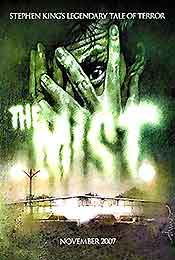 It goes like this: our heroes are in a car, surrounded by mist on all sides. After traversing what looks like quite a distance the vehicle conks out. The protagonist, an upright, square-jawed type played by Thomas Jane, decides the only way out is for everyone to die. The problem is the gun in his possession only has four bullets–and there are five people in the car. Jane solves the dilemma by fatally shooting each of his companions (including his own son) and then exits the car to face down the creatures in the mist. But at that point the mist clears and Jane is faced with a procession of radiation suit-wearing soldiers armed with flamethrowers, burning up everything in their path and leading several shell-shocked people to apparent safety. The End.
It goes like this: our heroes are in a car, surrounded by mist on all sides. After traversing what looks like quite a distance the vehicle conks out. The protagonist, an upright, square-jawed type played by Thomas Jane, decides the only way out is for everyone to die. The problem is the gun in his possession only has four bullets–and there are five people in the car. Jane solves the dilemma by fatally shooting each of his companions (including his own son) and then exits the car to face down the creatures in the mist. But at that point the mist clears and Jane is faced with a procession of radiation suit-wearing soldiers armed with flamethrowers, burning up everything in their path and leading several shell-shocked people to apparent safety. The End.
Obviously you can take those events in any number of ways. You may find Jane’s actions futile in light of the fact that the humans appear to have gotten the upper hand on the mist-monsters. One might also argue that he did the right thing shooting his companions, as the post-mist world looks considerably more oppressive than it did before (which can in turn be taken as a comment on our post-9/11 reality). But then maybe it’s Ms. Carmody who had the right idea, with her earlier blather about sacrifice being required to make things better.
Not too many horror films contain such a complex, thought-provoking finale. It may admittedly be a bit heavy for a movie featuring giant bugs, but I’ll have to give Darabont credit for making a film that isn’t afraid to really go for the throat. Far too many horror movie makers and viewers appear to have forgotten that these films exist not to reassure but to scare and provoke, and in those areas THE MIST definitely succeeds.
Still More Controversy
There are other negatives from an audience standpoint, including the fact that nearly everyone in the film is over 35 (youngsters like the twentyish Alexa Davalos and AMERICAN PIE’S Chris Owen are killed off early on), which seems certain to—-and apparently did—turn off the teenybopper crowd that flocks to most horror flicks.
And then the film didn’t show enough of its monsters. Or it showed too much. The protagonists don’t behave intelligently. The monsters are cheesy. Or they’re too slick. There’s too much gore. Not enough gore. Too much Ms. Carmody. Not enough Andre Braugher.
Virtually any complaint one can think of this movie has had thrown at it. You can say that about nearly any movie ever made, certainly, but not too many of them, in recent years at least, seem to rile people up like THE MIST.
Why? My theory is that, quite simply, audiences have become so conditioned to PG-rated snoozers like the recent PROM NIGHT remake (a big hit, sadly) or pandering torture fests of the SAW/HOSTEL variety that they can no longer handle a real horror movie—and THE MIST is indeed that rare animal (as are other hotly contested genre films from ‘07 like BUG and THE GIRL NEXT DOOR, but those were smaller, less commercial projects).
Old-fashioned in the best sense, THE MIST favorably recalls classics like FREAKS and NIGHT OF THE LIVING DEAD. As those films were in their time, it’s unabashedly shocking and audacious. What it’s not is a parody, remake, rip-off, post-modern critique or what have you. That puts THE MIST at odds with nearly every other scare picture currently in release, which if you ask me is strictly for the better.
The Black-and-White Version
I should take this opportunity to mention another feature of MIST that has been attracting attention, albeit of a more positive sort: the black-and-white version available on the DVD. Darabont claims he always intended to shoot in black-and-white, and this version showcases the film in an entirely different form—not necessarily better, but worth viewing for those wanting a new and interesting take on the film.
In black-and-white THE MIST feels like a recovered B-movie from the fifties, with a heightened and deeply atmospheric sense of unreality. In this way the B&W serves to enhance the CGI effects, making them harmonize eerily well with the flesh and blood actors. It makes me wonder why more special effects movies aren’t shot in B&W.
But I’m not in agreement with those critics who’ve been (over)praising this version of the film. What Darabont so painstakingly evoked in the full color release print, with its documentary-like handheld camerawork, is a sense of realism totally expunged in black-and-white. So while I think the latter version represents a worthy take on the film, it should not be considered the definitive one.
Other Interpretations
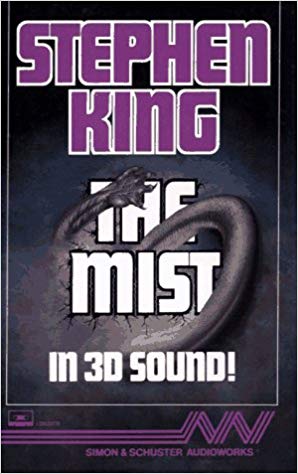 While on the subject of alternate versions of THE MIST, I feel duty-bound to mention two other incarnations of Stephen King’s tale, if only because they make for fascinating companion-pieces to Darabont’s film.
While on the subject of alternate versions of THE MIST, I feel duty-bound to mention two other incarnations of Stephen King’s tale, if only because they make for fascinating companion-pieces to Darabont’s film.
First is an early-eighties screenplay adaptation by the famed horror scribe Dennis Etchison, intended (rumor has it) for John Carpenter to direct. Although quite faithful to the novella, Etchison’s script is far different from the Darabont movie, and in my view not as potent.
For starters, Darabont wisely got the action underway quickly, with the protagonist leaving his house and heading to the supermarket within the first ten minutes. Etchison on the other hand takes 22 pages to get on the road, complete with an overdramatic husband-wife farewell scene.
This brings up the script’s chief flaw—it’s talky and drawn-out, with too much expositional dialogue. Example: during a climactic sojourn in a neighboring pharmacy Etchison wastes nearly a full page having his characters explain why it is that they’re still alive but all the pharmacy’s customers have died (because one building was ventilated and the other wasn’t). The characterizations are also a bit perfunctory, particularly Amanda the love interest, a strong and resourceful gal in Darabont’s version who exists in this script solely for an office make-out session, otherwise remaining largely off-screen.
Then there’s the ending. In contrast to King’s open-ended fade-out and Darabont’s ultra-grim one, Etchison opts for a neither-here-nor-there approach, having the protagonist and his companions take refuge in a motel just as they did in the supermarket. Thus we’re left with a coda that can seem optimistic or not depending on your point of view.
Etchison’s script never made it to the screen, but was adapted for a 1984 radio dramatization that was later released as a bestselling audio tape (see below). Utilizing a much-publicized “Kunstopf” 3-D recording system (with sounds piped into an artificial head that receives them exactly as a real one would), it’s an elaborate and painstaking piece of work that recalls everything great about the old-time radio serials.
The vocal actors, led by William Sadler (who also appears in the film), are quite good, though the severely congested kid who voices the protagonist’s child is damned obnoxious (I kept wishing he’d blow his nose). Excellent sound effects, too, particularly in the pharmacy sequence, with eerie moaning filling in for the monsters. The excess verbiage of Etchison’s script has been pared down, making for a lean and fast-moving narrative (this is one of the few instances where the abridgement is actually preferable to the full version). But the ending has been changed yet again, to an overly abrupt sign-out in which David thinks he hears a voice on his staticy car radio. A good, solid production, but of the four MIST codas outlined herein—King’s, Darabont’s, Etchison’s and now this one—it’s easily the least satisfying.
And there exists yet another version of THE MIST that deserves a mention: the 1985 Angelsoft developed computer game. It’s an old-school text adventure, meaning the whole thing is word-based, lacking pictures or music and related in the second person. It’s not much, frankly, focusing on elements of King’s story rather than its entirety; Mrs. Carmody the apocalypse obsessed “weird old witch” assumes paramount importance, and if the player makes the wrong move then “you” get thrown into the mist by Mrs. Carmody and her followers, where “three bird-like creatures swoop down on you. You scream in agony as they peck at you, but your death is quick.” Other ways to die include being “crushed by a hoary foot” and chomped by a giant spider: “Its bile begins to dissolve your flesh, and before you can scream it sucks your lungs out.” This MIST is ultimately most interesting, as with most eighties-era text adventure games, as a historical curiosity. Otherwise, though, it’s pretty worthless.
There was also a single season MIST TV series, broadcast on the Spike TV cable network in 2017. I’ll confess I only made it through the first episode, which I found interminable, a top-to-bottom rewrite of the story with a new set of characters. None of these people, who include a homeless drifter (Okezie Morro), an out-and-about teen (Russell Posner) and a teacher (Alyssa Sutherland) fired from her post for teaching sex eduction, are likeable or compelling in the slightest (although the filmmakers insist on providing detailed backstories), and the updated mini-mall setting far less potent than King and Darabont’s claustrophobic interiors. Skip it.
Conclusion
It’s rare to find a modern genre picture as fine as THE MIST, or as controversial. I’m certain its reputation will grow in the coming years, as the shock factor lessens and audiences are able to view the film for what it is: a horror movie that’s actually horrific. If you’ve been put off seeing it because of all the furor then now’s the time to rectify that mistake. View the film in black-and-white if you prefer, but by all means view it.

